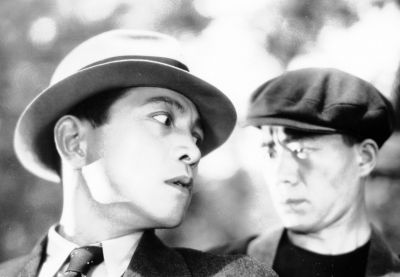
ANI IMOTO
(Ino and Mon, Giappone/1935) R.: Sotoji Kimura. D.: 74’
[Ino e Mon] T. int.: Ino and Mon. T. alt.: Older Brother Younger Sister. Sog.: da un racconto di Saisei Muroo. Scen.: Matakichi Eguchi. F.: Mikiya Tachibana. M .: Koichi Iwashita. Scgf.: Teruaki Abe. Mus.: Hidemaro Konoe. Su .: Jun Yamaguchi. Int.: Sadao Maruyama (Ino, il fratello maggiore), Chieko Takehisa (Mon, la sorella minore), Yoshio Kosugi (Akaza, il padre), Yuriko Hanabusa (Riki, la madre), Setsuko Horikoshi (San, la sorella più piccola), Heihachiro Okawa (Obata, uno studente), Keiji Sakakida (postino), Katsuji Honjo (postino). Prod.: P.C.L. 35mm. D.: 74'. Bn. Versione giapponese con sottotitoli inglesi / Japanese version with English subtitles
Da: National Film Center - The National Museum of Modern Art, Tokyo
Sotoji Kimura è uno dei maestri minori del cinema giapponese degli anni Trenta. Pur avendo girato film umoristici come Vita ebbra, il suo tono abitualmente era più cupo e spesso politicamente impegnato, come si confaceva a un regista formatosi nel movimento di sinistra Prokino. Questo film è tratto da un racconto di Saisei Muroo pubblicato nel 1934 e vincitore del Literary Confab Club Award. Il racconto appartiene alla fase centrale della produzione di Muroo, nella quale, come scrive Ivan Morris, "esplodono le passioni un tempo tenute a freno e lo stile si fa scandalosamente realistico". Il film di Kimura riproduce fedelmente il contesto operaio del racconto. Si apre con sorprendenti immagini in stile sovietico di lavoratori in riva al fiume e coglie in maniera convincente l'intensità drammatica del rapporto tra fratello e sorella e la divisione della famiglia tra campagna e città. Il racconto di Muroo fu portato sul grande schermo altre due volte, da Mikio Naruse nel 1953 e da Tadashi Imai nel 1976.
Alexander Jacoby, Johan Nordström
Sotoji Kimura is one of the unsung minor masters of Japanese cinema during the 1930s. While he was available for humorous works such as Tipsy Life, his tone was usually more sombre and often politically charged, as befits a filmmaker whose back- ground lay in the leftist Prokino movement. This film is his version of a short story by Saisei Muroo which had won the Literary Confab Club Award after its publication in 1934. The story is a product of the author's middle period, in which, as Ivan Morris writes, "passions once under con- trol now explode, and the manner becomes scandalously realistic". Kimura's film faithfully reproduces the working-class milieu of the story, with some striking Soviet-style imagery of workers by the river in the opening shots, and compellingly captures the dramatic intensity of the relationship between brother and sister and the familiar antagonism between the country and the city. Muroo's story was to be filmed twice more, by Mikio Naruse in 1953 and by Tadashi Imai in 1976.
Alexander Jacoby, Johan Nordström

Il Cinema Ritrovato 2013
 Il Giappone parla! Seconda parte. Cantanti e spadaccini
Il Giappone parla! Seconda parte. Cantanti e spadaccini
Tariffe:

Numero posti: 144
Aria condizionata
Accesso e servizi per disabili
Il nostro cinema aderisce al circuito CinemAmico: è possibile utilizzare l’applicazione MovieReading® per i film di cui è prevista audiodescrizione e/o sottotitolazione sull'applicazione.
Tel. 0512195311










